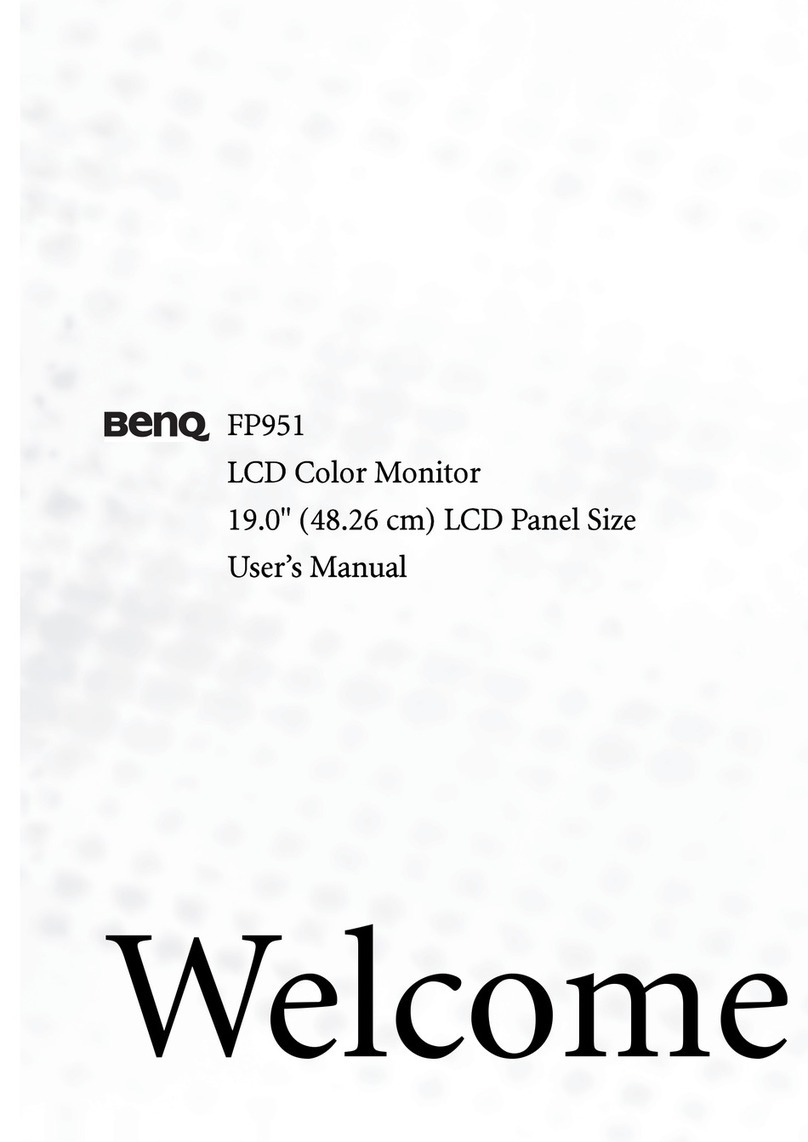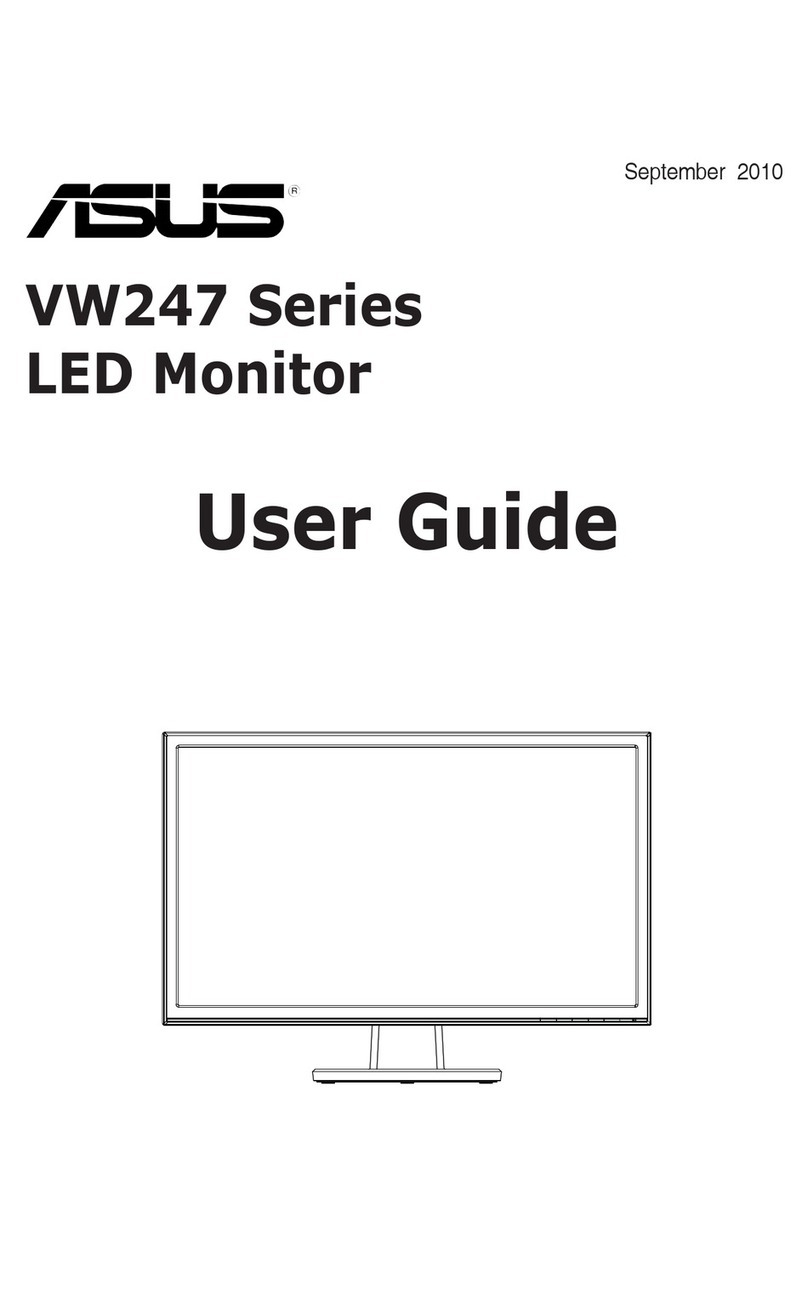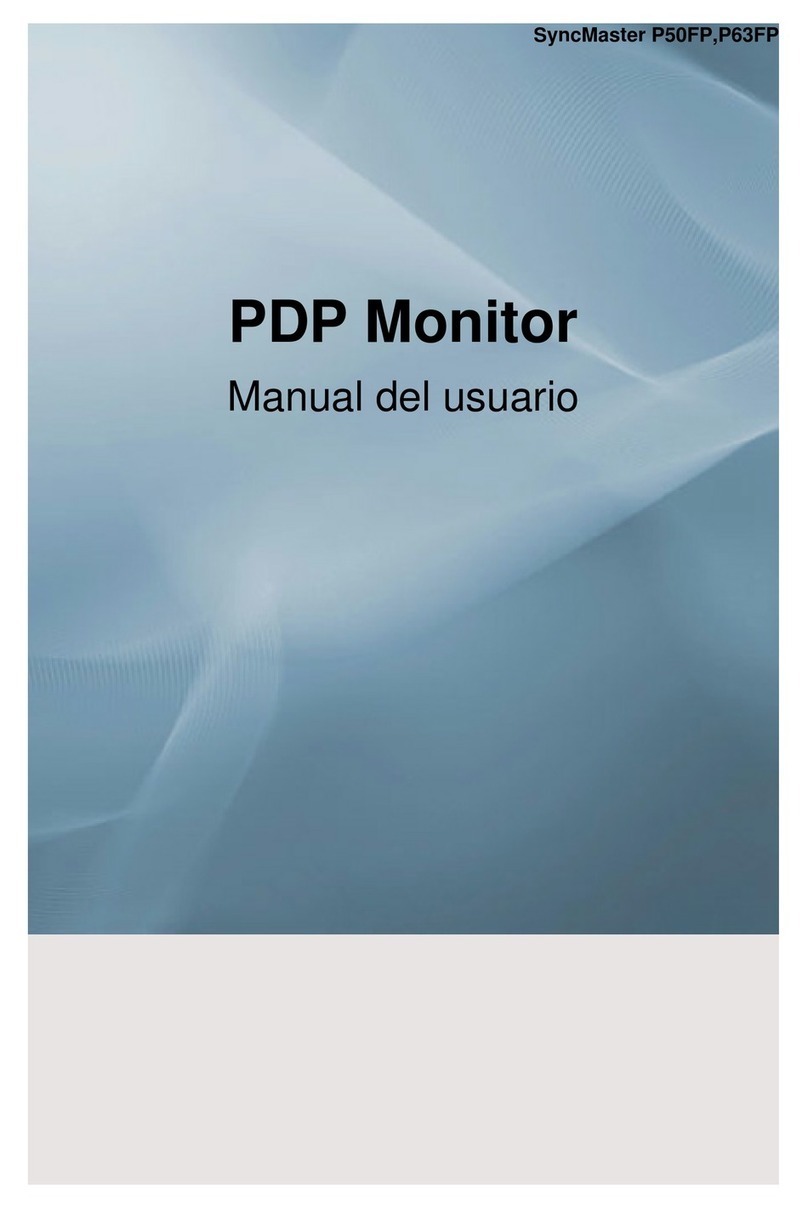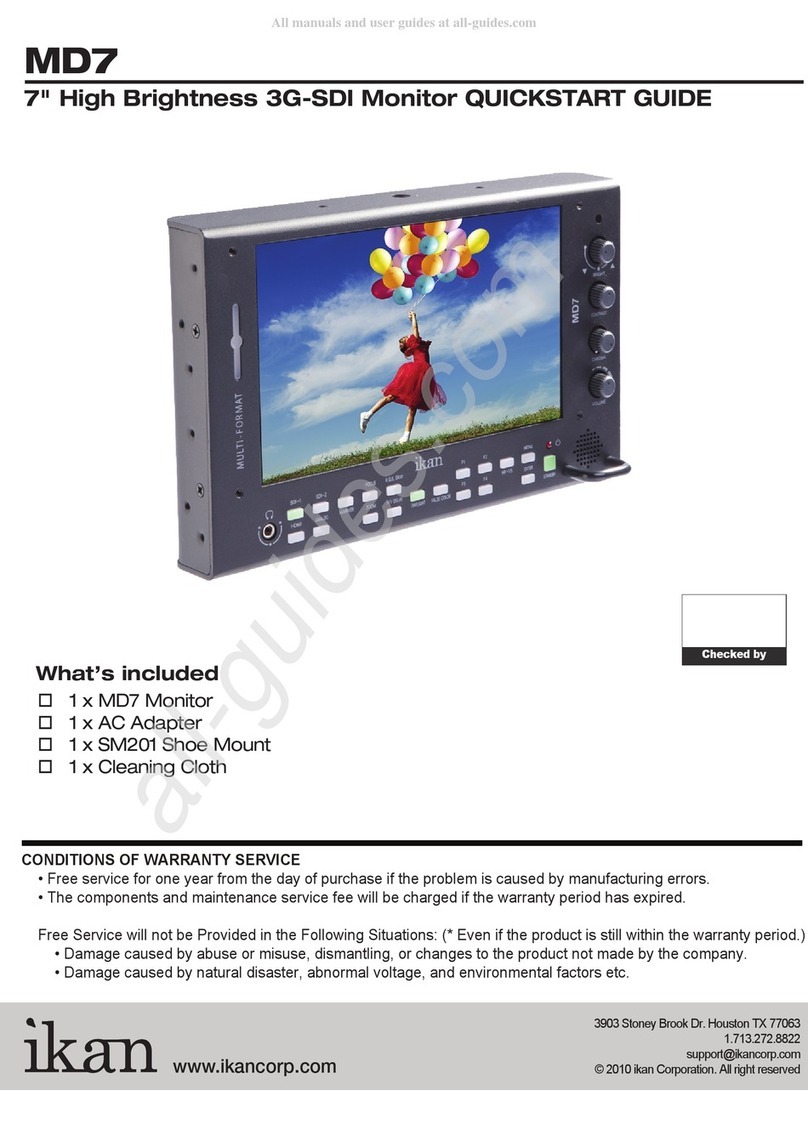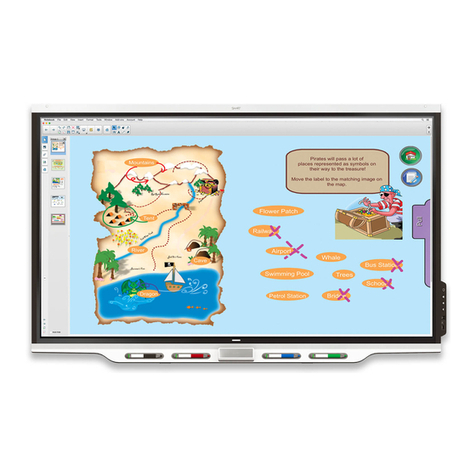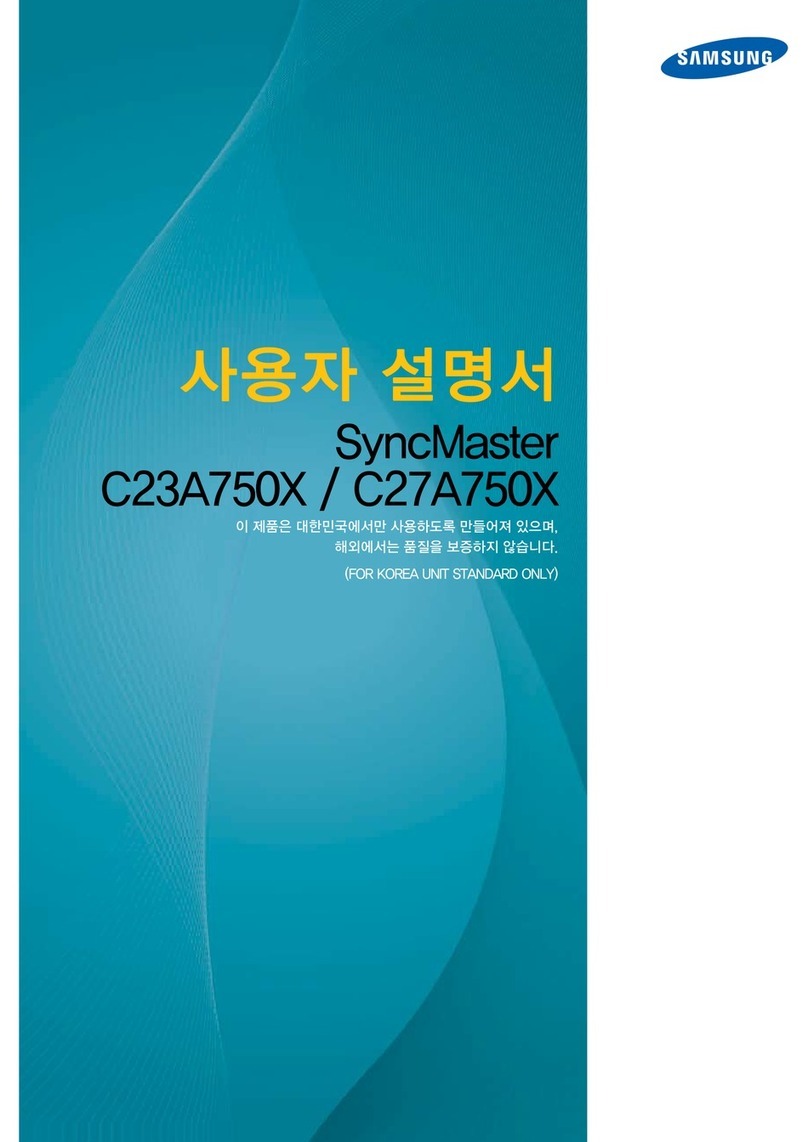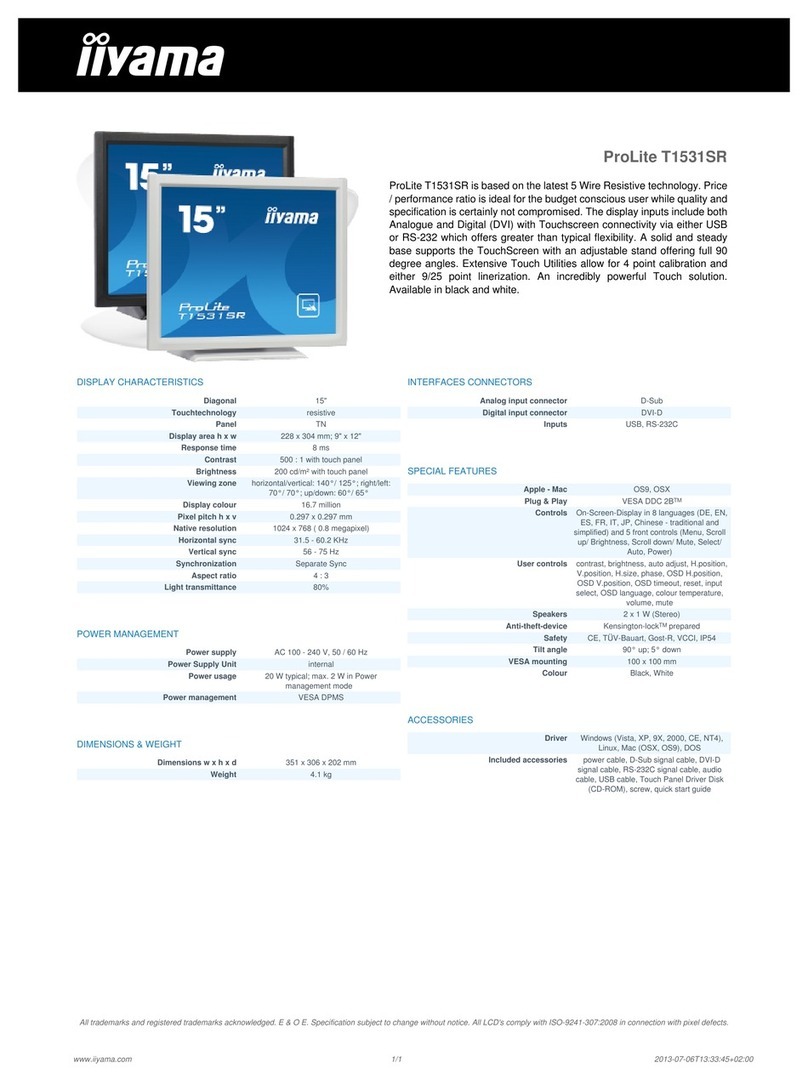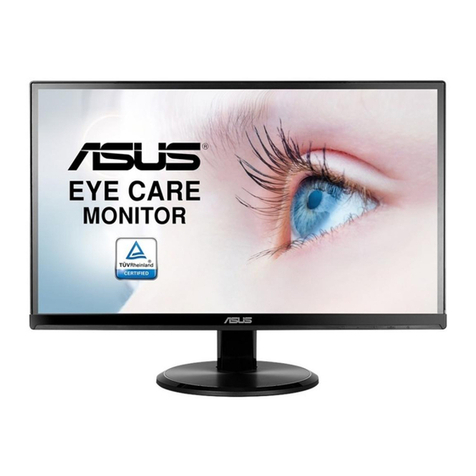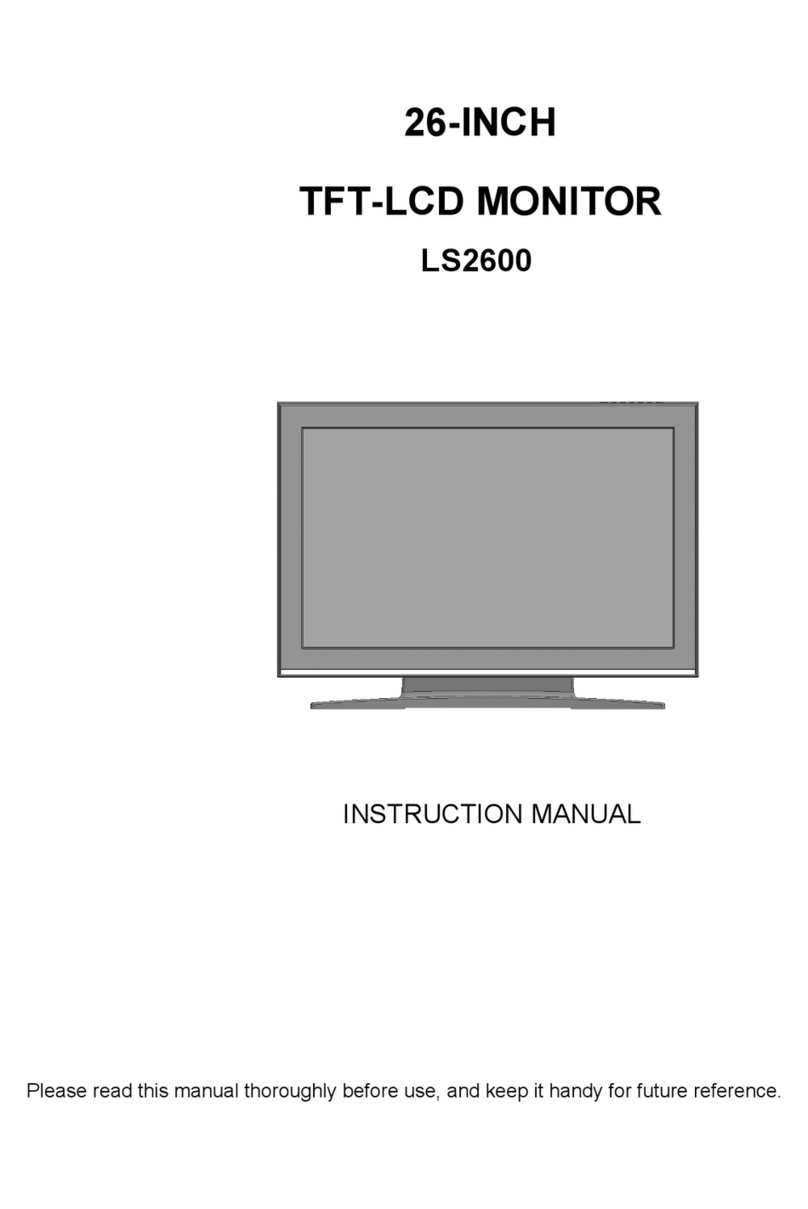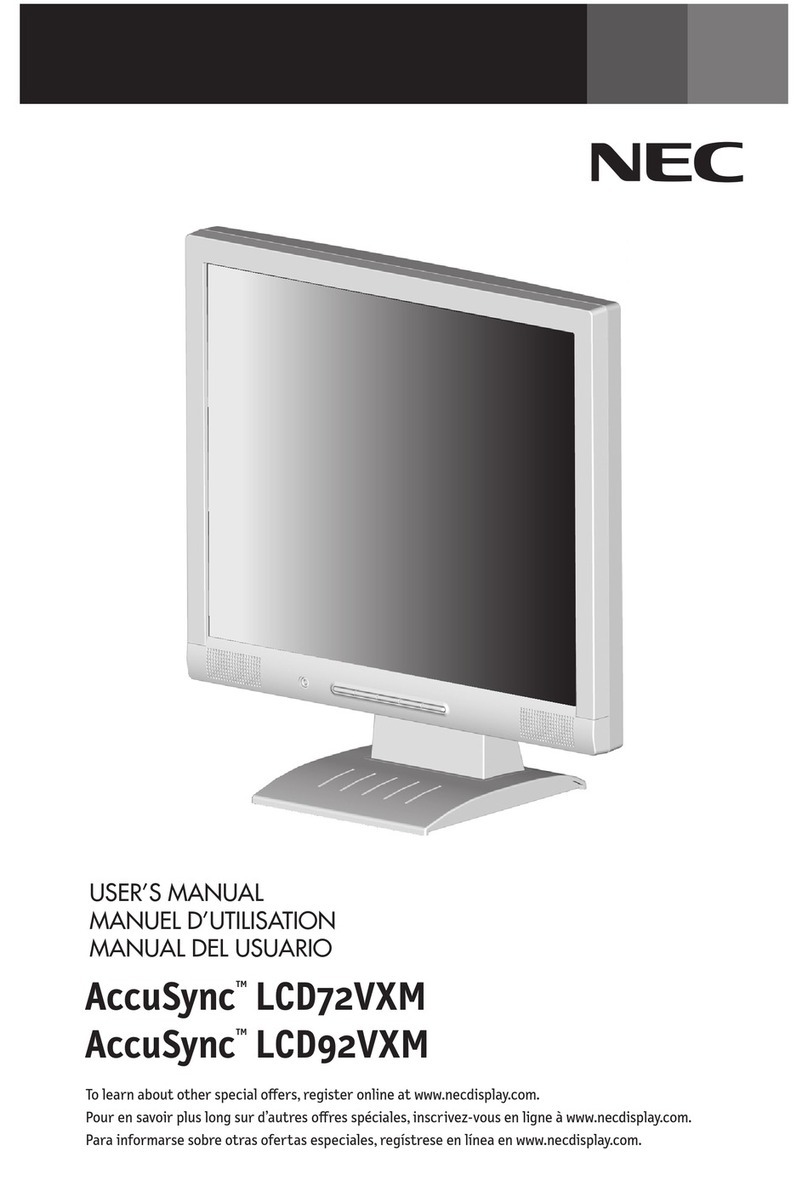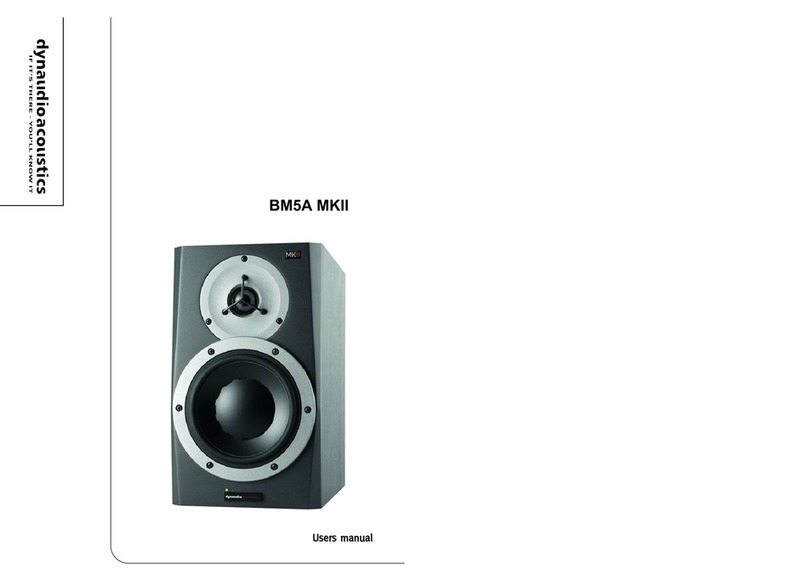Energy Star 220P4LPYES/00 User manual

22ƎLCD Color Monitor Chassis: Meridian 3
Service
Service
Service
Description Page
Table of Contents.........................................………….1
Revision List………….................................................2
Important Safety Notice…………................................3
1. Monitor Specifications….........................................5
2. LCD Monitor Description….....................................7
3. Operation Instructions….........................................8
3.1General Instructions…………………………….…...8
3.2 Control Buttons…………..…………………….…8
3.3 OSD Menu………………….................................9
4. Input/output Specification............................……10
4.1 Input Signal Connector.................................……10
4.2 Resolution & Preset Modes.................................11
4.3 Pixel Defect Policy…………………………………13
4.4 Failure Mode of Panel………………………….....15
5. Block Diagram………………………….................16
5.1 Scaler Board....................................………….....16
5.2 Power/USB Board................................…...........17
6. Schematic Diagram.............................................. 18
6.1 Scaler Board…………………….…………………18
6.2 Power Board.................................................…...23
6.3 Key Board…….…………………………………26
Description Page
6.4 Head Phone Board…………….…………………27
6.5 IR Board.................................................…...28
6.6 Daughter Board…….…………………………29
7. PCB Layout………………………………………...30
7.1 Scaler Board……………………………………..30
7.2 Power Board……………...………………………31
7.3 Key Board…….……………………………………32
7.4 Head Phone Board…………….…………………32
7.5 IR Board.................................................…...32
7.6 Daughter Board…….…………………………33
8. Wiring Diagram………………………………….…..34
9. Scaler Board Overview…………………………....35
10. Mechanical Instructions………………………....36
11. Repair Flow Chart…….……………………………39
12. ISP Instructions...…............................................43
13. DDC Instructions….............................................55
14. White Balance, Luminance Adjustment…...........68
15. Monitor Exploded View…....................................70
16. Recommended & Spare Parts List...….............71
17. General Product Specification………….……….73
SAFETY NOTICE
ANY PERSONATTEMPTING TO SERVICE THIS CHASSIS MUST FAMILIARIZE HIMSELF WITH THE
CHASSIS AND BE AWARE OF THE NECESSARY SAFETY PRECAUTIONS TO BE USED WHEN
SERVICING ELECTRONIC EQUIPMENT CONTAINING HIGH VOLTAGES.
CAUTION: USE A SEPARATE ISOLATION TRANSFOMER FOR THIS UNIT WHEN SERVICING
REFER TO BACK COVER FOR IMPORTANT SAFETY GUIDELINES
Copyright 2012 Philips Consumer Lifestyle Subject to modification ƻ
KAug.31, 2012
220P4LPYES/00
220P4LPYEB/00
220P4LPYEB/75

!!
Meridian 3
2 Revision List
Version Release Date Revision History
A00 Jul.27, 2012 Initial release, Draft Version
A01 Aug.17, 2012 Add CTN model 220P4LPYEB/00
A02 Aug.31, 2012 Add CTN model 220P4LPYEB/75

3
Meridian 3
Important Safety Notice
This electronic user guide is intended for anyone who uses the Philips monitor. Take time to read this user manual
before you use your monitor. It contains important information and notes regarding operating your monitor. The
Philips guarantee applies provided the product is handled properly for its intended use, in accordance with its
operating instructions and upon presentation of the original invoice or cash receipt, indicating the date of purchase,
dealers name and model and production number of the product.
Warnings
Use of controls, adjustments or procedures other than those specified in this documentation may result in exposure
to shock, electrical hazards and/or mechanical hazards. Read and follow these instructions when connecting and
using your computer monitor.
Operation
yKeep the monitor out of direct sunlight and away from stoves or any other heat source.
yRemove any object that could fall into ventilation holes or prevent proper cooling of the monitor’s electronics.
yDo not block the ventilation holes on the cabinet.
yWhen positioning the monitor, make sure the power plug and outlet are easily accessible.
yIf turning off the monitor by detaching the power cable or DC power cord, wait for 6 seconds before attaching
the power cable or DC power cord for normal operation.
yPlease use approved power cord provided by Philips all the time. If your power cord is missing, please contact
with your local service center. (Please refer to Customer Care Consumer Information Center)
y• Do not subject the monitor to severe vibration or high impact conditions during operation.
y• Do not knock or drop the monitor during operation or transportation.
Maintenance
yTo protect your monitor from possible damage, do not put excessive pressure on the LCD panel. When moving
your monitor, grasp the frame to lift; do not lift the monitor by placing your hand or fingers on the LCD panel.
yUnplug the monitor if you are not going to use it for an extensive period of time.
yUnplug the monitor if you need to clean it with a slightly damp cloth. The screen may be wiped with a dry cloth
when the power is off. However, never use organic solvent, such as, alcohol, or ammonia-based liquids to clean
your monitor.
yTo avoid the risk of shock or permanent damage to the set, do not expose the monitor to dust, rain, water, or
excessive moisture environment.
yIf your monitor gets wet, wipe it with dry cloth as soon as possible.
yIf foreign substance or water gets in your monitor, please turn the power off immediately and disconnect the
power cord. Then, remove the foreign substance or water, and send it to the maintenance center.
yDo not store or use the monitor in locations exposed to heat, direct sunlight or extreme cold.
yIn order to maintain the best performance of your monitor and use it for a longer lifetime, please use the monitor
in a location that falls within the following temperature and humidity ranges.
¾Temperature: 0-40°C 32-95°F
¾Humidity: 20-80% RH

!!
Meridian 3
4
yIMPORTANT: Always activate a moving screen saver program when you leave your monitor unattended.
Always activate a periodic screen refresh application if your monitor will display unchanging static content.
Uninterrupted display of still or static images over an extended period may cause “burn in”, also known as
“after-imaging” or “ghost imaging”, on your screen. “Burn-in”, “after-imaging”, or “ghost imaging” is a
well-known phenomenon in LCD panel technology. In most cases, the “burned in” or “after-imaging” or “ghost
imaging” will disappear gradually over a period of time after the power has been switched off.
Warning
Severe” burn-in” or “after-image” or “ghost image” symptoms will not disappear and cannot be repaired. The
damage mentioned above is not covered under your warranty.
Service
yThe casing cover should be opened only by qualified service personnel.
yIf there is any need for any document for repair or integration, please contact with your local service center.
(Please refer to the chapter of “Consumer Information Center”)
yFor transportation information, please refer to “Technical Specifications”.
yDo not leave your monitor in a car/trunk under direct sun light.
Note
Consult a service technician if the monitor does not operate normally, or you are not sure what procedure to take
when the operating instructions given in this manual have been followed.

5
Meridian 3
1. Monitor Specifications
Technical specifications

!!
Meridian 3
6
Note:
1. EPEAT Gold or Silver is valid only where Philips registers the product. Please visit www.epeat.net for
registration status in your country.
2. This data is subject to change without notice. Go to www.philips.com/support to download the latest version of
leaflet.

7
Meridian 3
2. LCD Monitor Description
The LCD monitor will contain a scaler board, a power board, a key board, an IR board, an audio board and an USB
board. The scaler board houses the flat panel control logic, brightness control logic and DDC.
The power board will provideAC to DC inverter voltage to drive the backlight of panel and the scaler board chips
each voltage.
Monitor Block Diagram
LED Panel
Scaler Board
LED Drive
Key Board
Video signal, DDC
HOST Computer
AC IN
100 ~ 240 V
Power Board
Aduio Board USB Board IR Board

!!
Meridian 3
8
3. Operating Instructions
3.1 General Instructions
Press the power button to turn the monitor on or off.
The other control knobs are located at front panel of
the monitor. By changing these setting, the picture
can be adjusted to your personal preference.
γThe power cord should be connected.
γPress the power button to turn on the monitor.
The power indicator will light up.
3.2 Control Buttons
Operating the Monitor
Connecting to your PC

9
Meridian 3
3.3 OSD Menu
On-Screen Display (OSD) is a feature in all Philips
LCD monitors. It allows an end user to adjust screen
performance or select functions of the monitors directly
through an on-screen instruction window. A user
friendly on screen display interface is shown as below:
Basic and simple instruction on the control keys
In the OSD shown above, you can pressźŸ buttons
at the front bezel of the monitor to move the cursor,
and press OK button to confirm the choice or change.
The OSD Menu
Below is an overall view of the structure of the
On-Screen Display. You can use this as a reference
when you want to work your way around the different
adjustments later on.

!!
Meridian 3
10
4. Input/ Output Specification
4.1 Input Signal Connector
D-sub Connector
Pin No. Signal Name
1 Red
2 Green/ SOG
3 Blue
4 Sense (GND)
5 Cable Detect (GND)
6 Red GND
7 Green GND
8 Blue GND
9 DDC +3.3V or +5V
10 Logic GND
11 Sense (GND)
12 Bi-directional data
13 H/H+V sync
14 V-sync
15 Data clock
DP Connector
Pin No. Signal Name
1 ML_Lane 3(n)
2 Ground
3 ML_Lane 3(p)
4 ML_Lane 2(n)
5 Ground
6 ML_Lane 2(p)
7 ML_Lane 1(n)
8 Ground
9 ML_Lane 1(p)
10 ML_Lane 0(n)
11 Ground
12 ML_Lane 0(p)
13 Ground
14 Ground
15 AUX_CH (P)
16 Ground
17 AUX_CH (N)
18 Hot Plug Detect
19 Return DP_PWR
20 DP_PWR
DVI Connector
Pin No. Description
1 T.M.D.S. data2-
2 T.M.D.S. data2+
3 T.M.D.S. data2 shield
4 No Connect
5 No Connect
6 DDC clock
7 DDC data
8 No Connect
9 T.M.D.S. data1-
10 T.M.D.S. data1+
11 T.M.D.S. data1 shield
12 No Connect
13 No Connect
14 +5V Power
15 Ground (for +5V)
16 Hot plug detect
17 T.M.D.S. data0-
18 T.M.D.S. data0+
19 T.M.D.S. data0 shield
20 No Connect
21 No Connect
22 T.M.D.S clock shield
23 T.M.D.S. clock+
24 T.M.D.S. clock-

11
Meridian 3
4.2 Resolution & Preset Modes
Maximum Resolution
1680 x 1050 at 60 Hz (analog input)
1680 x 1050 at 60 Hz (digital input)
Recommended Resolution
1680 x 1050 at 60 Hz (digital input)
Note:
Please notice that your display works best at native resolution of 1680 x 1050@60Hz. For best display quality,
please follow this resolution recommendation.
Power Management Definition
If you have VESA DPM compliance display card or software installed in your PC, the monitor can automatically
reduce its power consumption when not in use. If an input from a keyboard, mouse or other input device is detected,
the monitor will 'wake up' automatically. The following table shows the power consumption and signaling of this
automatic power saving feature:

!!
Meridian 3
12
The following setup is used to measure power consumption on this monitor.
·Native resolution:1680×1050
·Contrast: 50%
·Brightness: 250 nits
·Color temperature:6500k with full white pattern
Note:
This data is subject to change without notice.

13
Meridian 3
4.3 Pixel Defect Policy
Philips strives to deliver the highest quality products.
We use some of the industry's most advanced
manufacturing processes and practice stringent quality
control. However, pixel or sub pixel defects on the TFT
Monitor panels used in flat panel monitors are
sometimes unavoidable. No manufacturer can
guarantee that all panels will be free from pixel defects,
but Philips guarantees that any monitor with an
unacceptable number of defects will be repaired or
replaced under warranty. This notice explains the
different types of pixel defects and defines acceptable
defect levels for each type. In order to qualify for repair
or replacement under warranty, the number of pixel
defects on a TFT Monitor panel must exceed these
acceptable levels. For example, no more than
0.0004% of the sub pixels on a monitor may be
defective. Furthermore, Philips sets even higher quality
standards for certain types or combinations of pixel
defects that are more noticeable than others. This
policy is valid worldwide.
Pixels and Sub pixels
A pixel, or picture element, is composed of three sub
pixels in the primary colors of red, green and blue.
Many pixels together form an image. When all sub
pixels of a pixel are lit, the three colored sub pixels
together appear as a single white pixel. When all are
dark, the three colored sub pixels together appear as a
single black pixel. Other combinations of lit and dark
sub pixels appear as single pixels of other colors.
Types of Pixel Defects
Pixel and sub pixel defects appear on the screen in
different ways. There are two categories of pixel
defects and several types of sub pixel defects within
each category.
Bright Dot Defects
Bright dot defects appear as pixels or sub pixels that
are always lit or 'on'. That is, a bright dot is a sub-pixel
that stands out on the screen when the monitor
displays a dark pattern. There are the types of bright
dot defects.
One lit red, green or blue sub pixel
Two adjacent lit sub pixels:
- Red + Blue = Purple
- Red + Green = Yellow
- Green + Blue = Cyan (Light Blue)
Three adjacent lit sub pixels (one white pixel)
Note:
A red or blue bright dot must be more than 50 percent
brighter than neighboring dots while a green bright dot
is 30 percent brighter than neighboring dots.

!!
Meridian 3
14
Black Dot Defects Black dot defects appear as pixels
or sub pixels that are always dark or ‘off’. That is, a
dark dot is a sub-pixel that stands out on the screen
when the monitor displays a light pattern. There are
two types of black dot defects:
Proximity of Pixel Defects
Because pixel and sub pixels defects of the same type
that are near to one another may be more noticeable,
Philips also specifies tolerances for the proximity of
pixel defects.
Pixel Defect Tolerances
In order to qualify for repair or replacement due to pixel
defects during the warranty period, a TFT Monitor
panel in a Philips flat panel monitor must have pixel or
sub pixel defects exceeding the tolerances listed in the
following tables.
Note:
1. 1 or 2 adjacent sub pixel defects = 1 dot defect
2. This monitor is ISO9241-307 compliant .Class-I compliant.(ISO9241-307: Ergonomic requirement, analysis and
compliance test methods for electronic visual displays)
3. ISO9241-307 is the successor of formerly known ISO13406 standard, which is withdrawn by the International
Organisation for Standardisation (ISO) per: 2008-11-13.

15
Meridian 2
4.4 Failure Mode Of Panel
Failure description Phenomenon
Vertical block defect
Vertical dim lines
Vertical lines defect
(Always bri
g
ht or dark)
Horizontal block defect
Horizontal dim lines
Horizontal lines defect
(Always bri
g
ht or dark)
Has bri
g
ht or dark pixel
Polarizer has bubbles
Polarizer has bubbles
Foreign material inside
polarizer. It shows liner or
dot shape.
Concentric circle formed
Bottom back light of LCD is
brighter than normal
Back light un-uniformity
Backli
g
ht has forei
g
n material.
Black or white color, liner or
circular type
Quick reference for failure mode of LCD panel
this pa
g
e presents problems that could be made by LCD panel.
It is not necessary to repair circuit board. Simply follow the mechanical
instruction on this manual to eliminate failure by replace LCD panel.

!!
Meridian 3
16
5. Block Diagram
5.1 Scaler Board
D-Sub Connector
(CN101)
Panel Interface
(CN409)
Key Control Interface
(CN468)
Crystal
14.31818MHz
(X401)
Scalar IC
TSUMP58UHT5-2
(U401)
Flash ROM
MX25L4006EM1I
(U402)
DVI Connector
(CN102)
EEPROM
M24C02-RMN6TP
(U103)
EEPROM
M24C02-RMN6TP
(U129)
EEPROM
AZC398-04S.R7G
(U153)
DP Connector
(CN103)

17
Meridian 3
5.2 Power Board
DIM
ON/OFF
Feedback Circuit
MOSFET
(Q801)
PWM Control
OZ9998ALN
(IC801)
16V
LED
(CN802)
ZD802 L801
16V
EMI filter
Start Resistor
(R905,R908)
PWM Control
(IC901)
Transformer
AC input Bridge
Rectifier
and Filter
Feedback
Circuit
Rectifier
diodes
Power Switch
(Q901)
Photo coupler
(IC902)
Rectifier
diodes 5V
Audio IC
(U601)
CN601

!
18 Meridian 3
6. Schematic
6.1 Scaler Board (715G5431M01000004Q)
Remark: Parts position can be searched by using FIND function in PDF.
SDA_VGA
C116 5PF 50V
EDID_WP
BLUE-
DVI_CAB
RED-
GREEN-
HOT_PLUG DVISDA
DVI_CAB1 DVISCL
DVISCL
C129
NC/1000pF 50V
R127 10 OHM
R130 10 OHM
C130
100N 16V
FB105
300R 0.7A
I/O1
1
GND
2
I/O2
3I/O3 4
VDD 5
I/O4 6
U127
AZC398-04S
R133 10 OHM
R117 1K
R101 4.7K1/16W
C127
100N 16V
C110
100N 16V
R115 100OHM
Q126
NC/LMBT3904LT1G
I/O1
1
GND
2
I/O2
3I/O3 4
VDD 5
I/O4 6
U101
AZC398-04S
R141
1K
R112 10K
1 2
FB103 19R 0.5A
C128
100N 16V
C104 47NF 16V
C109 47NF 16V
R106
75R 1/16W 1%
R137 4.7K1/16W
3
1
2
D101
BAV70 1 2
FB104 19R 0.5A
R139 10K
R119
2.2K1/16W
1 2
ZD102
RLZ5.6B
3
1
2
D127
NC/BAV70
R116 100OHM
C108 47NF 16V
I/O1
1
GND
2
I/O2
3I/O3 4
VDD 5
I/O4 6
U102
AZC398-04S
R113 4.7K1/16W
R136
NC/10K 1/16W 5%
RX2-IN
C114
100N 16V
1
7
2
8
3
9
4
10
5
11
12
13
14
15
1716
6
CN101
DB15
RX2+IN
C102 47NF 16V
R111 100OHM
R138 4.7K1/16W
R134 10 OHM
R126 100OHM
C103 47NF 16V
RED+
C126
220N 10V
R140 100OHM
1 2
FB102 19R 0.5A
R104 56 OHM 1/16W
R114 100OHM
R120
2.2K1/16W
I/O1
1
GND
2
I/O2
3I/O3 4
VDD 5
I/O4 6
U126
AZC398-04S
FB126
300R 0.7A
1 2
FB101
60R 0.6A
R102 56 OHM 1/16W
R132 10 OHM
R118 1K
R110 100OHM
C112
33P 50V
R103 56 OHM 1/16W
Q127
NC/AO3401A
R135
100OHM
C107 47NF 16V
FB127
0R05 1/10W
1
2
3
4
5
6
7
8
17
18
19
20
21
22
23
24
9
11
13
15
10
12
14
16
25
26
CN102
JACK
R107
75R 1/16W 1%
R109 100OHM
C111
100N 16V
R131 10 OHM
R129 10 OHM
R105 470OHM1/16W
3
1
2
D126
BAV70
C105 1N 50V
E0
1E1
2E2
3VSS
4SDA 5
SCL 6
WC 7
VCC 8
U103
M24C02-RMN6TP
R142
NC/22K 1/16W 5%
1 2
ZD101
RLZ5.6B
R128 10 OHM
C101
220N 10V
C106
100N 16V
E0 1
E1 2
E2 3
VSS 4
SDA
5SCL
6WC
7VCC
8U129
M24C02-RMN6TP
I/O1
1
GND
2
I/O2
3I/O3 4
VDD 5
I/O4 6
U128
AZC398-04S
C113
220PF 50V
R10875R 1/16W 1%
+5V3,4,5,6
ESDA_5V
ESDA_5V
ESDA_5V+5V
DVI_5V
ESDD_5V
+5V
DVI_5V
ESDD_5V
DVI_5V
ESDD_5V
BIN 4
+5V
GNDR 4
DDCA_SDA4DDCA_SCL4
GNDB 4
DET_VGA 4
RIN 4
VSYNC 4
HSYNC 4
GIN 4
CLK+ 4
B- 4
GNDG 4
SOG 4
G+ 4
DVI_CAB 4
DDC_WP 4
CLK- 4
R- 4
B+ 4
DDCD_SDA 4
HPD_CTRL 4
R+ 4
DDCD_SCL 4
G- 4
1 2
ZD104
RLZ5.6B
R122
1K
DVISCL
DVISDA
C117 5PF 50V
RX1-IN
RX1+IN
VGA_CON
BLUE+
GREEN+
RXC+IN
RX2+IN
RX2-IN
RX1-IN
RX1+IN
HOT_PLUG
R121
1K
1 2
ZD103
RLZ5.6B
RX0-IN
RXC-IN
HOT_PLUG
RX0-IN
RX0+IN
VSI
RX0+IN
PC5V
HSI
RXC+IN
DVISDA
RXC-IN
SCL_VGA
PC5V
C115
5PF 50V
EDID_WP
DVI_CAB1
Input

19
Meridian 3
Remark: Parts position can be searched by using FIND function in PDF.
R163 NC
R153 0R05 OHM
R164 1M 1/16W
R166 10 OHM
R151 NC
R162 NC
R165 10 OHM
C151 220N 10V
R152 0R05 OHM
R155 0R05 OHM
R156 0R05 OHM
R154 0R05 OHM
R159 0R05 OHM
R161
1M 1/16W
CH1
1
CH2
2
VN
3
CH3
4
CH4
5NC 6
NC 7
VN 8
NC 9
NC 10
U152
AOZ8804DI
I/O1
1
GND
2
I/O2
3I/O3 4
NC 5
I/O4 6
U153
AZC398-04S
CH1
1
CH2
2
VN
3
CH3
4
CH4
5NC 6
NC 7
VN 8
NC 9
NC 10
U151
AOZ8804DI
R160 NC
R167
47K
C153
NC
R157 0R05 OHM
C152 220N 10V
SHELL1
21
SHELL2
22
ML_ Lane 3(n) 1
GND 2
ML_ Lane 3(p) 3
ML_ Lane 2(n) 4
GND 5
ML_ Lane 2(p) 6
ML_ Lane 1(n) 7
GND 8
ML_ Lane 1(p) 9
ML_ Lane 0(n) 10
GND 11
ML_ Lane 0(p) 12
GND 13
GND 14
AUX_CH(p) 15
GND 16
AUX_CH(n) 17
Hot Plug Detect 18
Return 19
SHELL4
24
SHELL3
23
DP_PWR 20
CN103
DP CONN
R158 0R05 OHM
+5V 2,4,5,6
VCC3.3
+5V
DP_RXN3P 4
+5V
VCC3.3
DP_RXN2P 4
DP_HPD 4
DP_RXN2N 4
DP_RXN1P 4
DP_RXN1N 4
DP_RXN3N 4
DET_DP 4
DP_RXN0P 4
DP_SDM 4
DP_AUXN 4
DP_RXN0N 4
DP_AUXP 4
DPRX-XX :
1. Trace Width-------- 0.25mm (PCB:2L)
2. Trace-Trace Gap-----0.14mm (PCB:2L)
3. –
ǂ㡡㊄㡡ǜбᜐɖǂ㎜ㆣⷂǂ
IC
⤐
4. R501 ~ R506
㏬ǂ
IC
⤐
DPRX-P1
DPRX-N0
DAN
HPD
DPRX-P2
DPRX-N1
DPRX-P0
DPRX-P3
DPRX-N2
DAP
DPRX-N3
DP INPUT

!
20 Meridian 3
Remark: Parts position can be searched by using FIND function in PDF.
POWER_KEY#
TO-SCALER-IN-R
TO-SCALER-IN-L
EE_SDA
EE_SCL
PS_ON
PS_OUTPUT
piovt
WP
DDC_CTRL
CN464,CN468 BOTH LAYOUT
on_PANEL
EE_WP
PS_DISTANCE
1
2
3
4
5
6
7
8
9
10
11
12
CN468
CONN
CE# 1
SO 2
WP# 3
GND 4
VDD
8
HOLD#
7
SCK
6
SI
5
U402
MX25L4006EM1I-12G
R4010
10K R4011
10K
VCC3.3
AUVRM
1
2
3
4
5
6
CN464
NC/CONN
AUVAG
R4013 100OHM
R4012 100OHM
UART_TXD
UART_RXD
DDC_SDA_COM
DDC_SCL_COM
No cable 1.095V
CABLE_DETECT
1Y0,2Y0
VGA
1.26V Power
1.5125V
TO-SCALER-IN-L
H
TO-SCALER-OUT-L
TO-SCALER-OUT-R
TO-SCALER-IN-R
Close to IC
with width
trace
TO Processor Board
DVI
DVI
A B
L
R457
100K1/16W
C450
100N 16V
Q466
LMBT3904LT1G
R456
4.7K1/16W
piovtOC_SW
Q467
LMBT3904LT1G
VCC3.3
VCC3.3
Cathode 1
Anode 2
Emitter2
3
Collector
4
Emitter1
5
OC401
ISA401
R459
10K
R458
NC/10K
1Y1,2Y1
R455
620 OHM 1/16W
RIN0P
51
GIN0P
48
SOGIN0
49
BIN0P
46
RIN0M
50
GIN0M
47
BIN0M
45
HSYNC0
54
VSYNC0
55
REXT 11
HOLDZ/PMGPIO06
20
WPZ/PMGPIO07
19
SDO
16
SCK
18 CSZ
15
SDI
17
LVACKM 123
XIN
42
XOUT
41
LVA2P 126
LVA2M 125
LVA1P 128
LVA1M 127
LVA0P 2
LVA0M 1
LVB3P 111
LVB3M 110
LVBCKP 113
LVBCKM 112
LVB2P 115
LVB2M 114
LVB1P 117
LVB1M 116
LVB0P 119
LVB0M 118
LVACKP 124
LVA3M 121
LVA3P 122
GND
3
GND
13
RX2P
69
RX2N
68
RX1P
66
RX1N
65
AVDDL_DP_126 35
RX0P
62
RX0N
61
RXCP
59
RXCN
58
GND
43
GND
63
GND
78
VDDP 92
MODE0
97
VDDP 120
DDCA_DA/RS232_TX0/PMGPIO22
53
DDCA_CK/RS232_RX0/PMGPIO21
52
DDCDA_DA/RS232_TX1/PMGPIO13
60
DDCDA_CK/RS232_RX1/PMGPIO12
57
AVDD_DP_33 23
VDDP 106
PMGPIO15/PMPWM0 71
GPIO27/PWM5 102
SAR0 6
SAR1 7
SAR2 8
GPIO11/PWM1 93
GPIO10/PWM0 94
MI2C_SDA/GPIO07 95
MI2C_SCL/ GPIO06 96
RESET
22
VDDC 108
AVDD_MPLL_33 44
GND
81
GND
99
GND
100
BYPASS
10
PMGPIO17/PMPWM2 72
AVDD_DVI_33 67
AVDD_PLL_33 101
SAR3 9
AVDDL_DP_126 29
LINE_IN_R
75
LINE_OUT_L
76
GPIO24/PWM2 105
LINE_IN_L
74
NC
64
VDDP 14
EAR_OUT_R(DAC_OUT_R)
82
GPIO26/PWM4 103
AUVRM
80
AUVAG
79
LINE_OUT_R
77
DP_HPD
39
DP_SDM
40
DP_AUXP
25 DP_AUXN
24
DP_RX0P
27
DP_RX0N
28
DP_RX1P
30
DP_RX1N
31
DP_RX2P
33
DP_RX2N
34
EAR_OUT_L(DAC_OUT_L)
83
VDDC 5
AVDD_LPLL_33 4
DP_RX3P
36
DP_RX3N
37
GND
107
GND
109
GND_DP
26
VDDC 85
GPIO25/PWM3 104
VCTRL 12
MODE1
98
GND_DP
32
AVDD_DP_33 38
AVDD_AUSDM_33 73
AVDD_EAR_33 84
AVDDL_DVI_126 56
SPDIFO/GPIO05 91
AUMCK/GPIO04 90
AUWS/GPIO03 89
AUSD/GPIO02 88
AUMUTE/GPIO00/PWM7 86
AUSCK/GPIO01/PWM6 87
PMGPIO00
21
HOTPLUG/PMGPIO14
70
D3.3VD1.26V
TSUMP58UHT5-2
VGA
VCC3.3
1 2
FB411
60R 0.6A
R430
220K OHM
C464100N 16V
R432
10K
R460
22K1/16W
C429
10UF 10V
R461
10K
C444 1N 50V
C442
22P 50V
1 2
FB404
60R 0.6A
Q464
LMBT3906LT1G
R408 100OHM
C410
100N 16V
R446
NC/10K
C452
220N 10V
Audio reference GND
R474
NC
C418
100N 16V
C445 1N 50V
C467100N 16V
C449
100N 16V
C425
100N 16V
TO power Board
Voltage
R444
0R05 OHM
R439
0R05 OHM
C441
220N 10V
1 2
ZD465
RLZ5.6B
LED_A
R417 100OHM
R426 1K
R449 NC/100OHM
C446 1uF 10V
R423 0R05 OHM
C443
22P 50V
LED_A
R466
NC
L
C447
1uF 10V
R487NC
C401
100N 16V
C426
10UF 10V
C402
10UF 10V
R477
56 OHM +-5% 1/8W
R437
24.9K 1%
R438
0R05OHM1/8W R452 100OHM
R490 0R05 OHM
R448 NC/100OHM
R427 10K
C404
100N 16V
R410 100OHM
R473 0R05 OHM
R411 100OHM
R424 100OHM
1 2
FB408
60R 0.6A
1 2
FB403
60R 0.6A
C431
100N 16V
C436
100N 16V
C412
100N 16V
R409 1K
C440 10UF 10V
R442 0R05 OHM
C434
100N 16V
C428
100N 16V
C437
100N 16V
R413
10K
R418 100OHM
1 2
FB409
60R 0.6A
C407
100N 16V
R416 100OHM
3.3V
L
R402
3.9K +-5% 1/10W
1 2
FB407
60R 0.6A
R440
0R05 OHM
R431
10K
C416
100N 16V
C433
100N 16V
1 2
ZD466
RLZ5.6B
R475
10K
C423
10UF 10V
VGA+DVI
C421
100N 16V
R419
10K
R414
120R05 1/10W
C432
10UF 10V
C422
100N 16V
R488NC
3.3V Power
C427
100N 16V
C408
100N 16V
R404
3.3KOHM 1/10W
R435
0R05 OHM
C438
220N 10V
C466NC
1.8034V
R429
220K OHM
2Y0 1
2Y2 2
2-COM 3
2Y3 4
2Y1 5
INH 6
GND 7
GND 8
B
9A
10 1Y3
11 1Y0
12 1-COM
13 1Y1
14 1Y2
15 VCC
16 U404
74HC4052D
C470
NC
C417
10UF 10V
1 2
FB405
60R 0.6A
R453 100OHM
R4823.9K1/16W
R445 10K
C415
100N 16V
R469
NC
R407 10K
R412 10K
C468NC
C414
10UF 10V
R422 100OHM
R428 1K
R436
0R05 OHM
R470
NC
C465NC
C430
100N 16V
Q465
LMBT3906LT1G
R476
NC
1 2
X401
14.31818MHZ/32PF
1 2
FB406
60R 0.6A
C439NC
C413
100N 16V
R443
0R05 OHM
TO-SCALER-OUT-L
1 2
FB410
60R 0.6A
R406 100OHM
KEY2
KEY1
C448
10UF 10V
R471 NC
R421 0R05 OHM
NC 1
NC 2
NC 3
VSS 4
SDA
5SCL
6WC
7VCC
8U403
M24C16
R465 0R05 OHM
R403
4.7K1/16W
R441
0R05 OHM
R434
10K
R467
10K+-5%1/16W
C411
10UF 10V
R401 100OHM
C435
10UF 10V
TO-SCALER-OUT-R
R4833.9K1/16W
C406
100N 16V
R447
NC/10K
1
2
3
4
5
6
7
CN401
NC/CONN
R433
47K
1
2
3
4
5
6
CN402
CONN
C424
100N 16V
R472
22K1/16W
FB412
NC/300OHM
1 2
FB401
60R 0.6A
1 2
ZD464
RLZ5.6B
C420
10UF 10V
C419
100N 16V
R4843.9K1/16W
R420 100OHM
R464
1 OHM +-5% 1/8W
R405
10K
1 2
FB402
60R 0.6A
R425 100OHM
C405
10UF 10V
R478
0R05OHM1/8W
R415 100OHM
C403
100N 16V
R468
22K1/16W
R489NC
C409
100N 16V
R479
NC
+5V
VCC3.3 3,6
AVDD_EAR_33
AVDD_LPLL_33
AVDD_MPLL_33
VDDP
AVDD_DVI_33
VCC3.3 AVDDL_DVI_126
AVDD_AUSDM_33
VDDC
VDDP
AVDD_EAR_33
AVDD_MPLL_33
AVDD_DP_33
AVDD_PLL_33
VCC3.3
VCC3.3
AVDDL_DVI_126
AVDD_DVI_33
VCC3.3
AVDDL_DP_126
AVDD_AUSDM_33
VCC3.3
AVDD_LPLL_33
+5V
+5V
+5V
VCC1.26
AVDD_PLL_33
AVDD_DP_33
+5V
AVDDL_DP_126
VDDC
+5V
+5V
VCC3.3
+5V
VCC3.3
VCC3.3
VCC3.3
G-2
DDCA_SCL2
on_BACKLIGHT 6
VCC3.3
DP_RXN0N3
B+2
RIN2
Adj_BACKLIGHT 6
BIN2
DP_RXN3N3
DVI_CAB 2
DDCD_SDA 2
DP_RXN1P3
HPD_CTRL2
DDC_WP 2
B-2
DET_VGA 2
Volume 6
G+2
GIN2
CLK+2
DP_SDM3
DP_RXN2N3
DP_AUXP3
DP_HPD3
GNDR2
DET_DP3
Audio_SD 6
MUTE 6
DP_RXN2P3
HSYNC2
DP_RXN0P3
VSYNC2
PA[0..9] 5
DDCD_SCL2
DP_RXN1N3
LT-SCL 5
SOG2
R+2
GNDB2
LT-SDA 5
DDCA_SDA 2
AUVAG
DP_AUXN3
PB[0..9] 5
R-2
AUVRM
on_PANEL 5
DP_RXN3P3
CLK-2
GNDG2
PS_ON
POWER_KEY#
UART_TXD
UART_RXD
PS_ON
PS_OUTPUT
PS_DISTANCE
LED_G
LED_A
DDC_SCL_COM DDC_SDA_COM
DDC_CTRL
LED_O LED_GN
PB3
PB2
PB1
PB7
PA3
PB4
PB6
PA0
PA2
PA4
PA9
PA5
PA8
PB[0..9]
PA7
PB8
PB0
PB5
LED_O
PA1
LED_GN
CABLE_DET
PB9
PA[0..9]
PA6
SDA
SCL
LED_G
CABLE_DET
R4002 0R05 OHM
R4001 0R05 OHM EE_SDA
EE_SCL
KEY1
EE_WP
KEY2
R4003 NC/0R05 OHM
R4004 NC/0R05 OHM
EE_SCL
EE_SDA
LT-SDA
LT-SCL
EE_SCL
EE_SDA
Scaler
This manual suits for next models
2
Table of contents
Other Energy Star Monitor manuals






